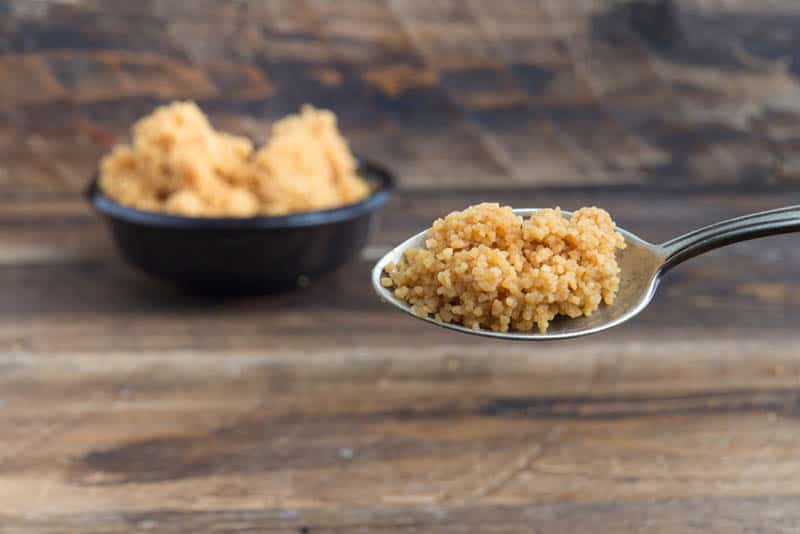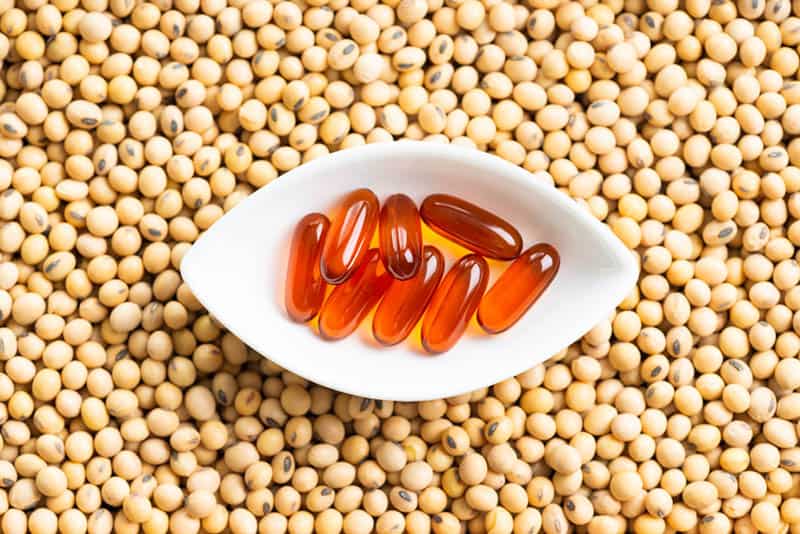Battling recurring clogs in your milk ducts can be incredibly frustrating and painful. It turns nursing into an experience you dread rather than enjoy and look forward to.
But with the help of a common food additive called lecithin, you can put an end to this problem for good!
Soy and sunflower lecithin breastfeeding supplements are a safe and effective solution for women who frequently suffer from plugged ducts, and they might also boost your milk production.
As a common supplement, it can be found in the food you eat every day and doesn’t usually have any serious side effects.
It works by minimizing the stickiness of your milk, allowing it to flow easily from the milk glands to your nipple without any clogs.
As well as taking supplements, you should also address any other issues that could be causing your milk ducts to clog, such as tight bras or an inefficient breast pump.
If you still find yourself experiencing nursing issues, you can consult a lactation consultant in your area to get tailored advice.
How Does Lecithin Help With Breastfeeding?

Lecithin is a food supplement that can be found in a variety of foods, such as milk, peanuts, soybeans, and meat.
It’s a phospholipid (it contains elements that are both hydrophilic and hydrophobic) and as it’s a common food additive, the chances are high that you’ve already consumed it in one form or another.
It’s most commonly sold as a soy or sunflower lecithin supplement that breastfeeding moms use to treat recurring plugged milk ducts.
But how exactly does it work? As it’s an emulsifier (a substance that allows two liquids such as water and oil to mix), it may increase the amount of polyunsaturated fatty acids, reduce the stickiness of breastmilk, and prevent plugged ducts from returning.
Taking 1200 mg (unless otherwise recommended) of soy or sunflower lecithin breastfeeding supplement four times per day should be sufficient to treat blocked ducts.
Potential side effects

As a rule of thumb, all women who are breastfeeding or pregnant should talk to their healthcare provider before taking any new medication or dietary supplements.
However, you should know that there are no known contraindications when it comes to taking lecithin supplements while breastfeeding, so you can expect your doctor to give you the all-clear.
I should note that it’s important to purchase soy or sunflower lecithin breastfeeding supplements from a reputable company, as dietary supplements aren’t required to undergo rigorous testing and evaluation by the United States Food and Drug Administration (FDA).
In fact, some supplements have been found to contain ingredients in amounts that don’t correspond to what’s printed on the label, so be sure to shop carefully!
I personally recommend Legendairy Milk Organic Sunflower Lecithin. Moms have raved about its ability to boost milk supply in addition to preventing plugged ducts, so it’s an excellent choice if you’re looking for an all-in-one breastfeeding supplement that doesn’t contain fenugreek.
Keep in mind that you shouldn’t take this lactation supplement while pregnant and that the company recommends waiting 4 to 6 weeks postpartum before introducing it into your diet.
If you’re interested in soy lecithin, you might want to look into Natural Nutra soft gel supplements.
You may have heard that soy or sunflower lecithin breastfeeding supplements contain choline, which might cause you to develop a fishy smell. However, the type of choline in this lactation supplement (called phosphatidylcholine) isn’t likely to make you smell fishy.
If this does happen, call your doctor and stop taking the supplements.
Soy Or Sunflower Lecithin Breastfeeding Supplements?

If you shop online for lecithin supplements, on Amazon, for example, you’ll find both soy and sunflower lecithin breastfeeding supplements.
Which one should you go with?
Unless you are allergic to soybeans, sunflowers, or a different source of lecithin, you can choose either one of them – the decision is up to you! The bottom line is that moms who breastfeed have found both to be a good way of treating clogged ducts.
Here are two suggestions:
Legendairy Milk Sunflower Lecithin
Natural Nutra Soy Lecithin Dietary Supplement
More On Treating Plugged Ducts

There’s nothing like a plugged milk duct to put a damper on your nursing journey. It causes breastfeeding to become painful, and if left untreated can lead to mastitis.
The milk ducts are responsible for transporting milk from the glands to your nipple. When a blockage occurs it can become difficult to breastfeed your baby, which is why it’s important to get rid of the clogs as quickly as possible!
While lecithin supplements can be a great ally in your fight against plugged ducts, and even improve your letdown, you should also check whether the blockages could be caused by any of the following:
• An uncomfortable bra that’s too tight for your postpartum boobs (I recommend wearing nursing or maternity bras during this time).
• You weren’t completely empty after feeding your baby or pumping.
• There was a disruption to your nursing or pumping schedule, causing your breasts to be full for a longer period of time.
• Your baby is struggling to latch deeper.
• Your baby has a medical condition (such as lip tie) that makes nursing difficult.
• You like to sleep on your stomach, which puts extra pressure on your chest.
• You have an oversupply of milk.
• You’re in the process of weaning your baby.
• Your breast pump isn’t doing a good job. Regardless of whether you’re using a manual, electric, or even a hands-free breast pump, it must be efficient at draining breast milk, otherwise, it will just cause you problems.
Addressing some of these issues (such as getting a more comfortable bra) should be relatively easy, while others may require the attention of an international board-certified lactation consultant (IBCLC) or doctor.
Try treating clogged ducts with any of the following solutions:
• Take a hot shower.
• Apply a warm compress.
• Massage the affected breast. Try pushing your hand from above the plugged milk duct and down to your nipple, and gently repeating the movement. Don’t try to press down on the blocked duct.
• Soak the affected breast in warm water with Epsom salt for at least 10 minutes.
• Wear comfortable, loose-fitting clothes whenever possible.
• Use gravity to your advantage. Try the “dangle feeding” nursing position, where you feed your baby on all fours.
Most importantly, keep feeding your baby from the affected breast. While it is painful, this is one of the most effective ways of clearing a clogged duct and will ensure your supply doesn’t significantly drop.
Use a pump when necessary, especially if your baby doesn’t completely empty your breasts after a feed.
This will also help you build up a supply of breast milk so other caregivers can feed your baby when you’re not home.
Plugged milk ducts or mastitis?

The symptoms of blocked milk ducts and mastitis are quite similar, so how can you tell the difference between the two?
The telltale signs of mastitis are fever and other flu-like symptoms, such as muscle aches and exhaustion. With a simple clogged duct, you shouldn’t have any symptoms that affect your entire body.
In addition, mastitis leads to redness, swelling, and tenderness of the entire affected breast, not just one part of it.
As this condition is usually caused by an infection you’ll need to see your doctor, who will most likely prescribe you with antibiotics.
Be prepared for a brief drop in milk supply – I recommend stocking up on foods that promote milk production so you don’t have to worry about supplementing with formula.
Even with the infection, you should keep nursing your baby or use a pump to empty your breasts as abruptly stopping could only make matters worse.
RELATED: How To Unclog Milk Ducts: 10 Best Strategies To Relieve Pain
The Bottom Line
No nursing mom wants to go through the pain and discomfort caused by clogged ducts and mastitis.
Breastfeeding is not a walk in the park, even without complications, so it’s natural that you would want to do everything in your power to prevent these painful conditions from returning.
Thankfully, soy and sunflower lecithin breastfeeding supplements are excellent for preventing future recurrences, allowing you to breastfeed your child without pain. What’s more, these supplements can also improve your supply and letdown!
This is especially important if you’ve recently dealt with a breast infection that has negatively affected your supply.
Generally speaking, these supplements are safe to use when nursing, but you should still discuss them with your doctor to make sure they won’t interfere with any other medication you’re currently taking.
If you start noticing a fishy odor, stop taking the supplements straight away.
Finally, always purchase your supplements from reputable companies with quality products to avoid wasting your money and potentially risking your health. When in doubt, ask your mom friends or look up online reviews to see what has worked for others!
References:
• “Lecithin use while breastfeeding”, Drugs.com. Retrieved from the Drugs.com website, (2020, October 4).
• “Blocked ducts and mastitis”, International Breastfeeding Centre. Retrieved from the International Breastfeeding Centre website. (2017, July).
Like this post? Please share or pin it for later. You can also stay in the loop and follow us on Facebook, Instagram or Pinterest.

We love honesty! Find Your Mom Tribe is an Amazon Associate and we earn from qualifying purchases through affiliate links at no extra cost to you. Please see our full Amazon Affiliate disclosure for more information.

